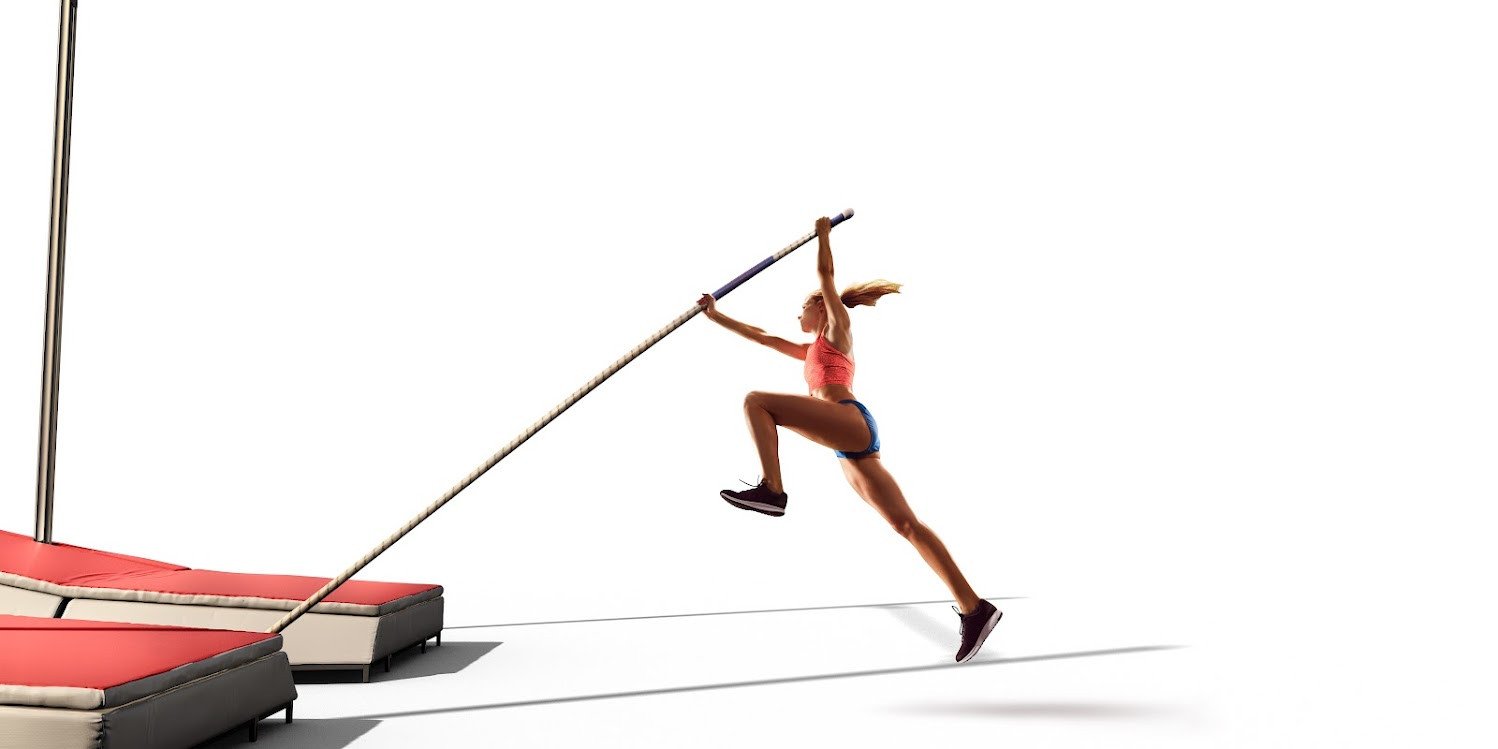EXERCISES TO IMPROVE THE TECHNIQUE
EXERCISES TO IMPROVE THE TECHNIQUE

SWING, ROCK-BACK AND EXTENSION Hold a rope in a high position and take a 3-5 stride approach, swing, rock back and extend the body parallel to the rope.
SWING ON ROPE OVER BAR Take a 3-5 stride run up, holding the rope in a high position, take of, swing back in the hang position, rock back at the beginning of the second swing to gain momentum and stretch, turn and clear an elastic bar.
5. TRAINING
During the period of training, the conditioning philosophy will be as follows:
Use an over distance approach.
First quantity, then quality.
Build a foundation of endurance and then develop speed gradually. This will prevent injury.
For the first month of training you will do no speed work and you will not time anything.
You will develop speed by doing a great deal of short, fast work and by improving your sprinting form.
The test distance for endurance will be 300m, and test distance for speed will be 30-50 m. A jumper will only be successful when both tests are done well.
As the season progresses, you will do less work but faster work.
Workouts will generally be a hard day followed by an easy day, with a lightening up of work two days before competition or time trail.
Your schedule is flexible. You may change the daily routine because of weather, body condition, or emotional outlook.
You should completely recover from one workout to the next. If you are not completely recovered, do less work, or rest.
You should never train when you are ill nor have an injury.
If your training schedule is limited, you may telescope this schedule into two-week periods instead of month periods.
Your workouts must be fun or rewarding, preferably both. 6. TRAINING SESSIONS
6.1.1. All training sessions should always start of with warm-up session and stretching exercises. 6.1.2. After all training sessions a cool down and stretching session should follow. 6.1.3. Refer to the chapter on mobility for event specific warm –up and stretching exercises.
7. TYPES OF TRAINING
7.1. MUSCLE ENDURANCE TRAINING
INTERVAL RUNS E.G.:
12 x 150 m @ 75% - rest 1 minute between reps.
8 x 200 m @ 75% - rest 1 minute between reps.
6 x 300 m @ 75 % - rest 2 minutes between reps.
BREAK DOWN INTERVAL RUNS E.G.:
(400 m, 300 m, 200 m, 150 m, 100 m) @ 75% - jog back
BUILD UP INTERVAL RUNS E.G.:
(150 m, 200 m, 300 m, 400 m) @ 75% - jog back.
PYRAMID INTERVAL RUNS E.G.:
(150 m, 200 m, 300 m, 200 m, 150 m) @ 75% - jog back
7.2. SPEED ENDURANCE TRAINING
NORMAL TEMPO RUNS E.G.:
6 x 110 m @ 90% - rest 1 minute between reps.
4 x 150 m @ 90% - rest 2 minutes between reps.
3 x 300 m @ 90% - rest 3 minutes between reps.
BREAK DOWN TEMPO RUNS E.G.:
(300 m, 200 m, 150 m, 100 m, 50 m) @ 90% - walk back.
BUILD UP TEMPO RUNS E.G.:
(50 m, 100 m, 200 m, 300 m) @ 90% - walk back.
PYRAMID TEMPO RUNS E.G.:
(50 m, 100 m, 150 m, 100 m, 50 m) @ 90% - walk back
COMBINATION TEMPO RUNS e.g. for a 60 sec. 400 m sprinter:
300 m in 45 sec., rest 30 sec. and sprint 100 m.
HOLLOW SPRINTS E.G.:
40 m sprint, 30 m cruise, 30 m sprint, and walk back.
STEP DOWN 200’S
Each successive 200 m is one second faster. Walk or jog between. When you can do 25-24-23, you can run a 47 sec. 400 m.
10 X 110M SPRINT @ 90% EFFORT.
Concentrate on correct form the last 30 m.
SPEED ENDURANCE TIME TRAILS
300 m sprint - take time
100 m sprint - take only time of last 30m
7.3. SPEED TRAINING
50 M DOWN HILL SPRINTING X 5
The slope must not be more than 6º.
FLYING 30’S
The athlete takes a flying start, and the time is taken between two beacons when the athlete is full speed.
30 m acceleration - 30 m sprint x 5
SPEED TIME TRAILS
50 m sprint - take time
bend sprint over 70 m - take time
30 m sprint from start.
RUNNING DOWN HILL - slope 6º - 5 x 50 m
ELASTIC BAND - exercise 5 x 10 m
MOTOR CYCLE PULL - 5 x 30 m with 30 m acceleration 8. TRAINING PROGRAMMES
Muscle endurance, speed endurance, rhythm drills and pure speed training forms a vital part of the jumper’s training program and is covered in detail in the manual for sprinting.
The exercises above, together with the jump technique exercises and strength training are combined in a long term training program that would look more or less as follows:
Make Your Business Online By The Best No—Code & No—Plugin Solution In The Market.
30 Day Money-Back Guarantee
Say goodbye to your low online sales rate!
What is the conditioning philosophy?
Conditioning philosophy is the approach that will be used while training. Train at a distance over an over distance approach.
How many times per week should I do speed work?
There is no one-size-fits-all answer to this question, as the amount and type of speed work that is necessary for each athlete will vary. However, general guidelines suggest that athletes should do a great deal of short, fast work, and improve their sprinting form, in order to improve their speed. Therefore, it is recommended that athletes do speed work at least three times per week.
How many times should I train each WEEK? And what will it look like?
Use an over distance approach. First quantity, then quality. Build a foundation of endurance and then develop speed gradually. This will prevent injury. For the first month of training you will do no speed work and you will not time anything. You will develop speed by doing a great deal of short, fast work and by improving your sprinting form.
What is the difference between a hard day and an easy day?
A hard day is a workout where the intensity is high. An easy day is a workout where the intensity is low.
As the season progresses, will my workouts become progressively harder?
Yes, the workouts will generally be a hard day followed by an easy day, with a lightening up of work two days before competition or time trail.
What type of interval training should I do?
There is no one-size-fits-all answer to this question, as the type of interval training that is most effective for you will depend on your individual fitness level, goals, and training schedule. However, some popular types of interval training include running and biking intervals, rowing intervals, and weightlifting intervals. You can also try interval training with strength training exercises, such as weightlifting or powerlifting intervals. Whatever type of interval training you choose, make sure to warm up and stretch beforehand to avoid injuring yourself.
What is the "cool down and stretching session"?
This is a session where you stretch after the workouts to help relieve any tension or soreness that may have developed.
What is the difference between a speed time trail and a running down hill?
Speed time trails are performed at a much faster pace but with a gradual build-up in speed towards the end of the trail. Running down hill is performed at a much faster pace from the start and the slope of the terrain makes it more challenging.
I am doing a x 200m @ 75% with a 1 minute rest in between reps. What is the fastest time I can achieve?
A 200m sprint time of 75% will take 1:30 minutes to complete.
What is the length of time for which I should be training for muscle endurance, speed endurance, and rhythm drills?
Muscle endurance and speed endurance should be trained for a period of 3-6 months, while rhythm drills and pure speed training can be trained for a period of 4-6 weeks.
What is the best way to improve muscle endurance?
There is no one-size-fits-all answer to this question, as the best way to improve muscle endurance depends on the individual's individual fitness level and training goals. However, some common methods for improving muscle endurance include Endurance training, Strength training, and Rhythm training.
What is the conditioning philosophy?
The conditioning philosophy will be to use an over distance approach and to first use quantity (more repetitions), then quality (faster reps). Speedwork will be introduced gradually so that no injuries occur.
What is the conditioning philosophy during the training period?
Use an over distance approach. First quantity, then quality. Build a foundation of endurance and then develop speed gradually. This will prevent injury. For the first month of training, you will do no speed work and you will not time anything. You will develop speed by doing a great deal of short, fast work and by improving your sprinting form.
What if I have to miss a day of work?
You will need to adjust your schedule accordingly. Generally, if you miss a day of work, you will do less work the following day. If you miss more than one day of work, you may need to rest or do less work.

